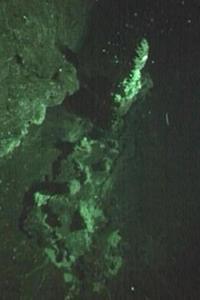
New Set of Deep-Sea Vents Comes to Light
A new set of deep-sea volcanic vents have been discovered in the Southern Ocean, a research team reported.
Scientists aboard the Royal Research Ship James Cook found the vents in what is the fourth discovery made by the team in three years, which suggests that deep-sea vents may be more common in the oceans than previously thought.
Using an underwater camera system, the researchers saw slender mineral spires about 10 feet (3 meters) tall, with hot water gushing from their peaks, and white mats of bacteria coating their sides. The vents are at a depth of 1,706 feet (520 m) in a newly discovered seafloor crater close to the South Sandwich Islands, a remote group of islands around 310 miles (500 kilometers) southeast of South Georgia.
"When we caught the first glimpse of the vents, the excitement was almost overwhelming," said team member Leigh Marsh, a University of Southampton graduate student who was on scientific watch at the time of the discovery.
Deep-sea vents are hot springs on the seafloor , where mineral-rich water nourishes lush colonies of microbes and deep-sea animals. In the three decades since scientists first encountered vents in the Pacific, around 250 have been discovered worldwide. Most have been found on a chain of undersea volcanoes called mid-ocean ridges, however, and very few are known around the Antarctic.

"We're finding deep-sea vents more rapidly than ever before," said team leader Paul Tyler of the University of Southampton. "And we're finding some in places other than at mid-ocean ridges, where most have been seen before."
By studying the new vents, the team hopes to understand more about the distribution and evolution of life in the deep ocean, the role that deep-sea vents play in controlling the chemistry of the oceans, and the diversity of microbes that thrive in different conditions beneath the waves.
Sign up for the Live Science daily newsletter now
Get the world’s most fascinating discoveries delivered straight to your inbox.
The researchers were exploring so-called Adventure Caldera, a craterlike hole in the seafloor 1.8 miles (3 km) across and 0.5 miles (750 m) deep at its deepest point. Despite its size, Adventure Caldera was only discovered last year by geophysicists from the British Antarctic Survey.
The current expedition is scheduled to end in Punta Arenas, Chile, on Feb. 22.










